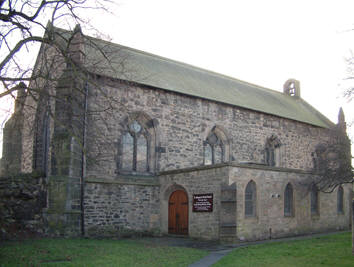Restalrig Collegiate Church

Restalrig Collegiate Church
Unfortunately, there is hardly anything left of Restalrig Collegiate Church and what there is has been incorporated into the present parish church – St Margaret’s (King’s Chapel).
James III (1460 – 1488. b. 1430) had built and endowed the parish church of Restalrig. On 6th May 1487, John Frissel submitted a petition to Pope Innocent VII (reigned 1484 – 1492) requesting that a collegiate church of the Holy and Indivisible Trinity and St Mary the Virgin, be erected within the bounds of the parish church. On 13th November 1487 this was confirmed by Papal Bull.
In 1487 the collegiate church is described as a ‘Chapel Royal’, reminiscent of the Chapel Royal within the bounds of Stirling Castle and is also described as ‘the King’s chapel beside the parish church of Restalrig’. Ten years later the dean is designated as being of ‘the chapel royal of Restalrig’. The original foundation provided for a Dean but failed to specify the number of Prebends.
It seems that Prebends were not created until 1512 when Pope Julius II (reigned Julius II 1503 – 1513) was petitioned by James IV (1488 – 1513 b. 1473) to renew and confirm the privileges granted to the chapel in original charter which had been granted to his father. James IV then granted the Dean to the church of Rothesay (a parish church and which was never a collegiate church). Still later this was subdivided into six Prebends which were described as the Bute primo – Bute sexto. In October 1512 a further two Prebends were founded by the king, one known as the King’s Werk and the other St Triduans Aisle, and were confirmed by James V (1513 – 1542 b. 1512) three years later in October 1515. James V also created another Prebend at that time named after Ross the first Provost of the Collegiate Church and who had later become Bishop of the diocese of Ross. There were two other Prebends one in memory of Provost Thomas Dickson (who died 1513) who which little is known and the other dedicated to St Jerome. The 1560 General Assembly of the Reformed Church order the collegiate church to be demolished and this was duly done.
Here again we find similarities with Rosslyn Chapel. A collegiate church founded and endowed to provide the same purpose and function as Rosslyn Chapel. The principle difference is that the ‘family’ which founded the collegiate church was none other than the Royal family. The St Clair family built and endowed one collegiate church – Rosslyn Chapel. The Royal family (because the were richer and owned far more land and property than a local landowner such as the St Clairs) built and endowed collegiate churches in several parts of their kingdom.